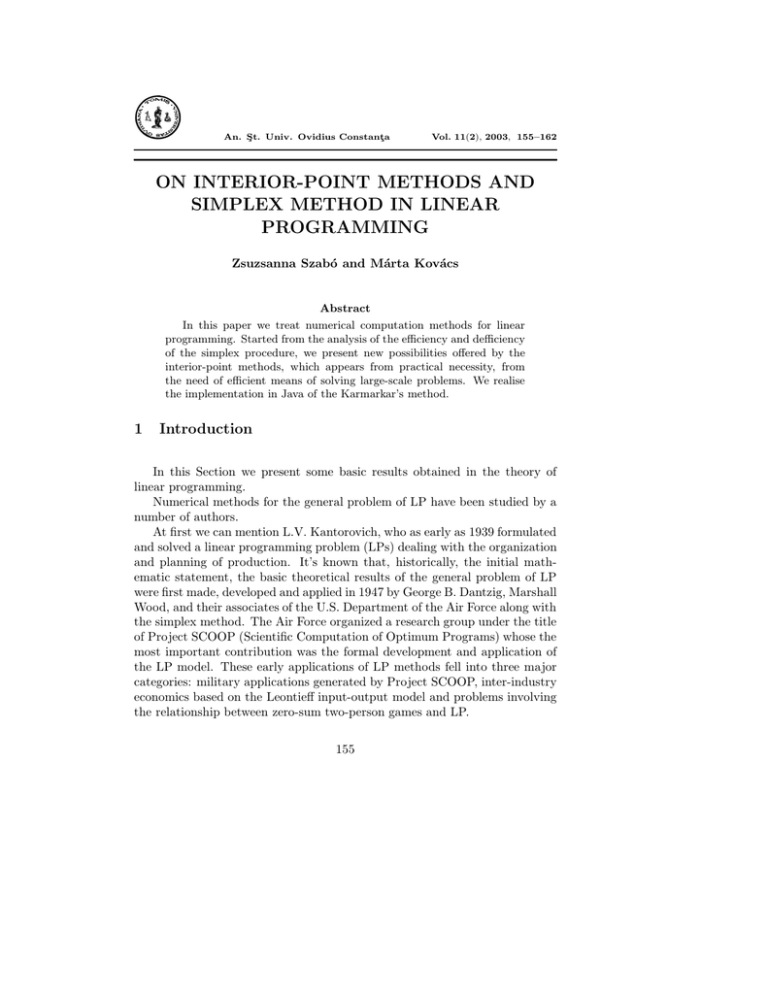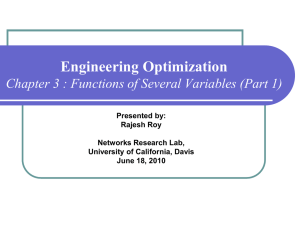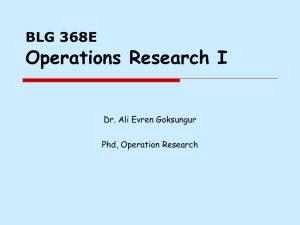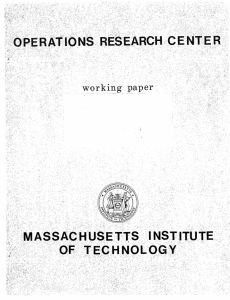ON INTERIOR-POINT METHODS AND SIMPLEX METHOD IN LINEAR PROGRAMMING Zsuzsanna Szab´
advertisement

An. Şt. Univ. Ovidius Constanţa
Vol. 11(2), 2003, 155–162
ON INTERIOR-POINT METHODS AND
SIMPLEX METHOD IN LINEAR
PROGRAMMING
Zsuzsanna Szabó and Márta Kovács
Abstract
In this paper we treat numerical computation methods for linear
programming. Started from the analysis of the efficiency and defficiency
of the simplex procedure, we present new possibilities offered by the
interior-point methods, which appears from practical necessity, from
the need of efficient means of solving large-scale problems. We realise
the implementation in Java of the Karmarkar’s method.
1
Introduction
In this Section we present some basic results obtained in the theory of
linear programming.
Numerical methods for the general problem of LP have been studied by a
number of authors.
At first we can mention L.V. Kantorovich, who as early as 1939 formulated
and solved a linear programming problem (LPs) dealing with the organization
and planning of production. It’s known that, historically, the initial mathematic statement, the basic theoretical results of the general problem of LP
were first made, developed and applied in 1947 by George B. Dantzig, Marshall
Wood, and their associates of the U.S. Department of the Air Force along with
the simplex method. The Air Force organized a research group under the title
of Project SCOOP (Scientific Computation of Optimum Programs) whose the
most important contribution was the formal development and application of
the LP model. These early applications of LP methods fell into three major
categories: military applications generated by Project SCOOP, inter-industry
economics based on the Leontieff input-output model and problems involving
the relationship between zero-sum two-person games and LP.
155
156
Zsuzsanna Szabó and Márta Kovács
The first successful solution of a LP problem on a high speed electronic,
digital computer, occured in January 1952, on the National Bureau of Standards Computer (SEAC).
The used computation method was the original simplex procedure, but the
need for efficient means of solving LPs especially large-scale problems has led
to the design and implementation of highly complex computerized procedures,
mathematical programming systems (MPS).
The simplex method is the central computational element of MPS and this
method works so well in practice, but the computational process could break
down for large values of m and n, and even for reasonably sized problems.
S. Smale (1983), K.H. Borgwardt (1982), V. Klee and G.J. Minty (1972)
constructed a class of problems for which the simplex algorithm could be made
to pass through all extreme points. This ”worst case” problems require a 2d −1
iterations, where d is the number of variables in an m = 2d inequality problem.
The Klee-Minty problems show that the simplex method is an exponentialtime algorithm.
For detailed discussion on computational complexity one may use, for example, Papadimitriou and Stieglitz (1982), Lenstra (1982), R.M. Karp (1975),
J. Telgen (1979), S. Smale (1983).
Thus the simplex algorithm does not have a polynomial bound, but works
well in practice. Some papers treated the simplex method from this point of
view, that useful property of the simplex method, which assure that in practise
we can obtain the solution, became a very interesting subject for researchers.
After 1970, a new direction has appeared. In 1979, L.G. Khachiyan published the ellipsoid algorithm. This method embeds the solution space of the
joint primal-dual inequality problem in progressively smaller ellipsoids, each
of which guaranteed to contain the optimal solution, if one exists.
An iterative step is the determination of the new ellipsoid. Khachiyan
showed that the optimal solution can be obtained within a polynomial-bounded
number of iterations.
This method was an important theoretical development but has not replaced the simplex method (see E.L. Lawler (1980), M.W. Browne (1979)).
In 1984, Narendra Karmarkar, a mathematician at AT&T Bell Laboratories, published another polynomial time algorithm for LPs.
Karmarkar’s algorithm uses spheres and projective geometry to construct
a sequence of points converging to a solution of a LP problem.
For more detailed description of Karmarkar’s method one can read Hooker
(1986), Parker and Rardin (1988) and Murty (1989).
Since the Karmarkar’s publication appeared there an extensive research of
the algorithms for LP has been done. The Khachiyan and Karmarkar algorithms are interior-point (IPM) algorithms and takes a fundamentally different
ON INTERIOR-POINT METHODS AND SIMPLEX METHOD IN LINEAR
PROGRAMMING
157
approach from the simplex method (S. Wright (2002)).
2
Karmarkar’s Method
The famous paper of Karmarkar inspired many people. There are more
than 2000 papers on IPMs and there are hundred of variations.
In this Section we present the Karmarkar’s method.
Karmarkar’s method is applied to an LP in the following form:
⎧
⎪
⎪f (x) = (c, x) → min
⎪
⎨Ax = 0
(KF )
⎪x1 + · · · + xn = 1
⎪
⎪
⎩
x≥0
where A is an m × n matrix and c = (c1 , . . . , cn ).
The LP must satisfy the conditions that:
1
1
0
,...,
x =
∈ S,
n
n
where S is the feasible set, and the optimal value of the objective function
must be (fmin = 0).
The (KF) form doesn’t present a restriction, since any LP can be transformed in this form. This procedure will be described in the following.
Let us consider the following LP model:
⎧
⎪
⎨f (x) = (x, c) → min
Ax ≤ b
⎪
⎩
x≥0
and its dual formulation
⎧
⎪
⎨g(y) = (y, b) → max
AT y ≥ c
⎪
⎩
y ≥ 0,
(2.1)
(2.2)
where f : Rn → R, A ∈ Mm,n , c ∈ Rn , b ∈ Rm .
Using (2.1) and (2.2), we can formulate a new LP model which objective
function will be the duality gap. Thus, we can write
158
Zsuzsanna Szabó and Márta Kovács
⎧
h(x, y) = f (x) − g(y) → min
⎪
⎪
⎪
⎨Ax ≤ b
⎪
AT y ≥ c
⎪
⎪
⎩
x ≥ 0, y ≥ 0.
(2.3)
Certainly, if (x0 , y 0 ) is the optimal solution for (2.3), then we’ll have hmin = 0
and x0 will be optimal for the considered problem.
Thus it’s sufficient to solve only the LP model (2.3).
To bring (2.3) in the standard form, we’ll introduce auxilliary variables,
n
u ∈ Rm
+ , and v ∈ R+ , namely:
⎧
h → min
⎪
⎪
⎪
⎨Ax + u = b
(2.4)
T
⎪
A
y
−
v
=
c
⎪
⎪
⎩
x ≥ 0, y ≥ 0, u ≥ 0, v ≥ 0
If we denote by
M = max{bi , cj },
i,j
then we can introduce a new restriction:
⎧
h → min
⎪
⎪
⎪
⎪
⎪
⎪
⎪Ax + u = b
⎪
⎨AT y − v = c
n
m
m
n
⎪
⎪
⎪
x
+
y
+
u
+
vj ≤ 2(n + m)M
i
j
i
⎪
⎪
⎪
⎪
i=1
j=1
i=1
j=1
⎪
⎩
x ≥ 0, y ≥ 0, u ≥ 0, v ≥ 0.
(2.5)
Next we introduce a new variable denoted by w1 (w1 ≥ 0 is necessary to
preserve a standard form of the problem) and the variable w2 such that we
have w2 = 1 and we can write:
⎧
h(z) → min
⎪
⎪
⎪
⎪
⎪
Ax + u − bw2 = 0
⎪
⎪
⎪
⎪
⎪
AT y − v − cw2 = 0
⎪
⎪
n
m
m
n
⎪
⎨
xi +
yj +
ui +
vj + w1 − 2(n + m)M w2 = 0
(2.6)
⎪
⎪
i=1
j=1
i=1
j=1
⎪
⎪
n
m
m
n
⎪
⎪
⎪
⎪
x
+
y
+
u
+
vj + w1 + w2 = 2(n + m)M + 1
i
i
i
⎪
⎪
⎪
⎪
i=1
j=1
i=1
j=1
⎪
⎩
x ≥ 0, y ≥ 0, u ≥ 0, v ≥ 0, w1 ≥ 0, w2 ≥ 0.
ON INTERIOR-POINT METHODS AND SIMPLEX METHOD IN LINEAR
PROGRAMMING
159
Using the substitutions xi = (M + 1)xi , i = 1, n, yj = (M + 1)yj , j = 1, m,
ui = (M + 1)ui , i = 1, n, vj = (M + 1)vj , j = 1, m, wl = (M + 1)wl , l = 1, 2,
we can write:
⎧ h(z ) → min
⎪
⎪
⎪
⎪
⎪
Ax + u − bw2 = 0
⎪
⎪
⎪
⎪
⎪
AT y − v − cw2 = 0
⎪
⎪
n
m
m
n
⎪
⎨
x1 +
yj +
uj +
vi − 2(n + m)M w2 = 0
(2.7)
⎪
⎪
i=1
j=1
j=1
j=1
⎪
⎪
n
m
m
n
⎪
⎪
⎪
⎪
x
+
y
+
u
+
vi + w1 + w2 = 1
⎪
i
j
j
⎪
⎪
⎪
i=1
j=1
j=1
i=1
⎪
⎩ x ≥ 0, y ≥ 0, u ≥ 0, v ≥ 0, w ≥ 0,
which is the (KF) form associated to the considered LP model.
To apply the Karmarkar’s method, first we must determine the projection
of a vector onto the set of x satisfying Ax = 0.
Next, for a given feasible point xk ∈ S, we must use the Karmarkar’s cennot
k
tering transformation associated
with
nthe point kx as T ((x1 , . . . , xn ); xk ) =
k
(y1 , . . . , yn ) where yj = xj /xj /
r=1 xr /xr . To obtain a new point
xk+1 in the original space by using the centering transformation to determine
the point corresponding to y k+1 , the restriction
n
i=1
xi +
m
j=1
yj +
m
j=1
uj +
n
i=1
vi + w1 + w2 = 1
n
k
is essential. We will obtain a new point: xk+1
= xkj yj /
j
r=1 xr yr , j =
1, n.
In the following we present the algorithm.
Karmarkar Algorithm:
2
Step 1
Let x0 = n1 , . . . , n1 ;
k = 0.
Step 2
If (c, xk ) < ε then xk optimal
else go to Step 3
160
Zsuzsanna Szabó and Márta Kovács
Step 3
Determine the next feasible solution xk+1 such that:
Calculate
y
k+1
=
1
1
...
n
n
T
−
θ(I − P T (P P T )−1 P )[Diag(xk )]cT
c n(n − 1)
and use the centering transformation:
xk+1 = T −1 (y k+1 , xk )
k = k + 1;
return to Step 2.
2
In algorithm P denote (m+1)×n matrix whose first m rows are A[Diag(xk )]
and θ ∈ (0, 1) is chosen to ensure convergence of the algorithm.
Karmarkar showed that if we project [Diag(xk )]cT (not cT ) onto the feasible
region in the transformed space, then, for some δ > 0, it will be true that, for
k = 0, 1, 2, . . . ,
f (xk ) − f (xk+1 ) ≥ δ.
Since f (xk ) is decreased by at least δ per iteration, it follows that by choosing
k sufficiently large, we can ensure that the value of the objective function for
xk is less than ε.
In the following we present the first iteration numerically.
We considered the following LP model in (KF) form:
⎧
f (x) = −x1 + 2x2 → min
⎪
⎪
⎪
⎨
x1 − 2x2 + x − 3 = 0
⎪
x
1 + x2 + x − 3 = 1
⎪
⎪
⎩
x ∈ R3+ .
1.
We have: A = (1 −2 1), n = 3, x0 = 31 13 13 . Let ε = 10
ON INTERIOR-POINT METHODS AND SIMPLEX METHOD IN LINEAR
PROGRAMMING
For k = 0 we get
⎛ 1
1
1
⎜ 3
, Diag(x0 ) = ⎝ 0
f (x0 ) = >
3
10
0
1
2 1
−
A · Diag(x0 ) =
3
3 3
1
2 1
3 −3 3
P =
1
1 1
2 0
T
P ·P = 3
0 3
⎛
0
1
3
0
1
0
⎜ 2
T
T −1
0
P0 = (I3 − P (P P ) P ) = ⎝ 0
− 21 0
⎞
⎛
− 31
⎟
⎜
(Diag x0 ) C T = ⎝ 2 ⎠
3
0
T
θ −1 0 1
6
6
.
y 1 = 31 13 31 − √
3 · 2 2/36
161
⎞
0
⎟
0 ⎠
1
3
⎞
− 12
⎟
0 ⎠
1
2
We chose θ = 41 ∈ (0, 1) and we get:
y 1 = (0, 4055 0, 3333 0, 2611).
To obtain a new point x1 in the original space we used the centering transformation. We can write
x11 =
x01 y11
x01 y11 + x02 y21 + x03 y31
x11 = 0, 4055
x12 =
x02 y21
x01 y11 + x02 y21 + x03 y31
x12 = 0, 3333
x13 =
x03 y31
x01 y11 + x02 y21 + x03 y31
x13 = 0, 2611
162
Zsuzsanna Szabó and Márta Kovács
We got:
x1 = (0, 4055 0, 3333 0, 2611)
f (x1 ) = −0, 4055 + 2 · 0, 3333 = 0, 2611 >
1
10
With the obtained new point x1 , we can start the next iteration.
3
Conclusion
If we would like to compare in runtime the simplex method with Karmarkar’s method, we can observe than neither is faster then the other in all
problems.
The practical efficiency of both methods depends strongly on the details
of their implementation.
The number of iterations required by Karmarkar’s method is typically between 10 and 100. The simplex method needs 2n − 3n iterations, where n is
the number of primal variables.
Thus generally the IPMs are better for large-scale problems.
References
[1] S. Wright: Interior - Point Methods, Computer Sciences Department, University of Wisconsin - Madison, 2002.
[2] Wayne L. Winson: Operations Research, PWS - Kent Publishing
Company, 1991.
[3] Saul L. Gass: Linear Programming, An International Thomson
Publishing Company, 1985.
[4] G. Meinsma: Interior - Point Methods, University of Twente, 1997.
Petru Maior University of Tg.Mureş, România









